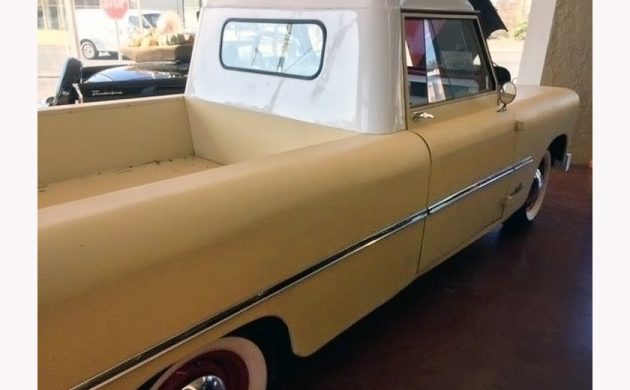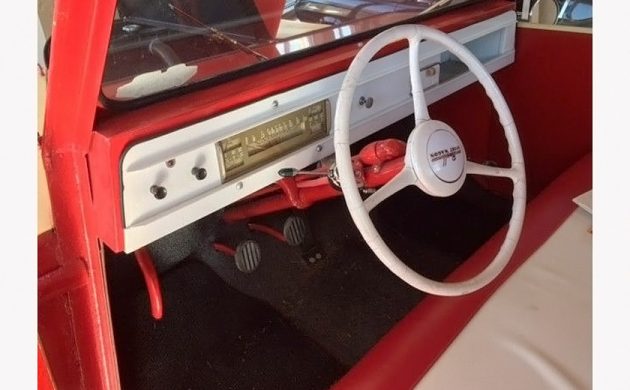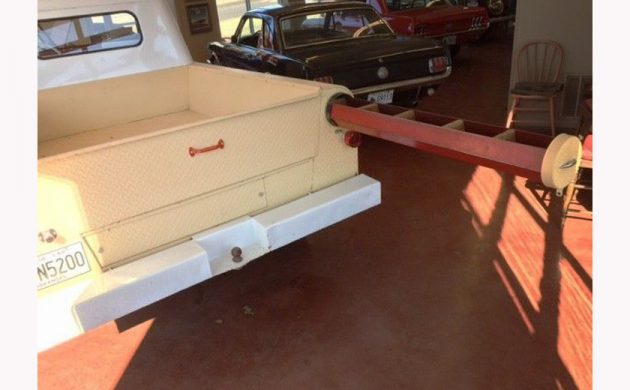If a person likes unusual and interesting vehicles but they also need a pickup, it doesn’t get much better than this 1956 Powell Deluxe Sport Wagon. Even being a lifelong car fanatic I have never seen one in person other than in a museum once. This super rare truck can be found here on eBay with a buy it now price of $18,500 and a current bid price of $7,600 but the reserve isn’t met. It’s located in Hot Springs National Park, Arkansas, which as I look outside and see a few inches of fresh snow, sounds pretty good to me. Ikey H. comes through again with another great find – thanks, Ikey!
The photos aren’t the best with most of them being somewhat chopped off, but most of us know what a Powell pickup looks like. This pickup, or Sport Wagon – the other one was a Station Wagon with enclosed cargo area – has been for sale before, maybe more than once with various asking prices. It looks like a nice example and truthfully you probably won’t find a nicer one for sale in the US. Hopefully, being either from or in the south, rust would be less of an issue than if it were a northern vehicle – it looks solid underneath. The Powell Manufacturing Company in Compton, California reportedly made between 1,000 and 1,200 of these pickups and the seller of this example says that it “is one of two running examples”. The Powell Registry shows between 100 and 150 Sport Wagons surviving today but their condition isn’t known. I don’t think that this is only one of two running examples as I have seen quite a few others online.
This is a unibody, or unit-body, pickup somewhat similar to Ford’s Unibody pickups from 1961-1963. The clincher for the Powell vehicles is that they sat on a 1941 Plymouth chassis and they used 1941 Plymouth drivetrains with a fiberglass front cap! No, really. Here’s an old photo of the plant workers cleaning up the old chassis. The Powell brothers, Hayward and Channing, were known for their radios in the 1920s and scooters from the 1930s to the 1960s. The pickups were well-received by car magazines of the day and I can’t think of a more eye-catching vintage truck to have today. Powell’s goal was to be able to sell a $1,000 truck and by using those used-but-totally-rebuilt Mopar chassis and drivetrains they came close to meeting that goal.
This is a Deluxe Pickup which had a two-tone interior and they also had a diamond-plate tailgate and rear bumper, dead giveaway signs of a Deluxe. I don’t know if the red painted hood and cowl would be original but I like it. Yellow and red is a great combo for a vintage vehicle in my opinion. White walls on a pickup always sort of looks a bit cartoony to me but I think it works here.
There are so many unique design aspects of a Powell Sport Wagon but maybe the most unique would be the storage tubes above one or both tail lights which were used for storing fishing poles. This one has been modified with compartments which would be handy for tools but it sure would be cool to be able to put a couple of bamboo fishing rods in there and drive down an old trail to a remote trout lake in something like this.
A flathead 201 cubic-inch Plymouth, or reportedly sometimes Dodge, engine would have powered these trucks. When they came out in 1955, using already 14-year-old technology may not have been the best long-term marketing move. Reviewers thought that they were a great second vehicle and I would absolutely love to have one. Unfortunately, the very thing that helped the company to provide an inexpensive truck resulted in them ending production at the end of 1956 due to a lack of early-40s Plymouth chassis. I love a good entrepreneur story and when it involves vehicles I love it even more. The Powell brothers seemed to have a winner on their hands but things didn’t last as long as they had hoped, with the result being but a few dozen rare examples left today.







I always admired what Powell did with these trucks, but I have never understood the business plan. How many 1941 Plymouths did they expect to find in junkyards within reasonable distance of LA?? What did they plan to do when the stocks dried up? Obviously they didn’t plan, because the chassis supply dried up and they just quit. It all seems weird.
Allpar has some details on the Powell; presumably since it uses a Plymouth chassis it is considered part of the Chrysler extended family:
https://www.allpar.com/old/powell.html
I’d certainly agree that the Powell business plan, if you can even call it that, was really bizarre. I guess they were looking to make a few bucks on these as long as they could and then move on to something else.
It looks like a vehicle out of a classic cartoon. Didn’t Foghorn Leghorn drive one of these on the farm? Again, as we’ve said and heard many times, “rare doesn’t always equate to desirability.”
Hahaha. Probably so. It could have been an early LT as in Looney Toons
The plan Powell used for building this cool pickup doesn’t seem like it would have been practical to me. First, you have to find junked ’41 Plymouths. Did the junkyard remove the bodies or did the Powell workers do it? If done on site, Powell had to pay the yard for the labor involved in removing the body from the chassis, then pay for the chassis itself. Then the Powell workers had to go get it, bring it to the factory and prep it for the pickup. Or did Powell pick up the whole ’41, bring it to their shop and strip it themselves and then devote time and labor disposing of the body? Either way, it was time and money. You’d think it would have been more cost efficient to just buy a chassis from Plymouth. No prep work involved, just add the pickup body and whatever else was needed. If it cost a little more, build that into the price; you’d probably still be able to offer the pickup at a reasonable price. Plus, I don’t know how I’d feel about a new pickup on a used chassis. When you consider how Powell went about building their pickup, I’m surprised they sold as many as they did.
Even Dave Wright will tell you,( if they haven’t cut him off with their non-member commenting policy now) this the rarest vehicle to come through here, and brought to us by none other, than the king himself. Wouldn’t it be great if someone, hopefully American, would offer something like this again. Hello Harley? This would turn things around for ya’, forget the bikes. Look at the firewall, what 4 wires and a coil? Ok, maybe a better suited drive train, ( H-D twin probably puts out more power than the flattie) some ecoboost 4 cylinder and a 6 speed, maybe, then I suppose, you couldn’t have the 4 wire firewall,,tell you what, better idea, hang an O/D or tall rear end gears and use as is, if you dare, that is. Really belongs in a museum.
Is this the same Powell Motors that produced “The Homer?”
“Whether you’re driving near or far, Powell makes a pow-pow-powerful car!”
It has a chassis. It’s not a unibody. Powell had no stamping dies, just a press brake, which accounts for the simple curves in the body panels. Plymouth was a good choice because Mopar parts were, and still are, plentiful. The fact that they quit production because they ran out of 1941 junker Plymouths doesn’t jibe, because Dodge, DeSotos and low-level Chryslers used the same chassis. There was another reason why production stopped, don’t know if it was legal, political and/or financial.
Charles, I was referring to the Ford Unibody pickup where the cab and box weren’t separate units like with most pickups, not as in a body-and-frame-as-one-unit unibody. I guess I could have worded it better, thanks for the catch.
Oddly though the body is welded directly to the Plymouth chassis with various lengths of angle iron and flat steel. It’s funny how they were assembled – Ute style – bed incorporated to cab but when it’s on the lift, I can’t open the doors.
Paint it “Metallic Pea”, and you have a “Family Truckster”, from the film Vacation!
how to tell the “sports wagon” frm “pick up”?
This is the only place I’ve seen (twice now I believe) or heard of these.
Thanks Scotty!
Both the pickup truck and the station wagon Powell’s are called Sport Wagon.
What – you guys forget about WWII ? Lots of good bodies went to those scrap drives.
I can’t imagine the 1946 chassis and drivetrain would have been radically different, if unchanged at all from the 41’, like most cars after the war. Go figure.
Powell trucks and wagons were built 55-57 so parts from the P12 and later models were used. Most Powell’s had a P12 201CID engine. My PMC-2018 has a 218 or 230 Dodge engine – haven’t measured the stroke yet.
These are unique! Love the fishing rod holders. A Honda Ridgeline of the era…
Kind of reminds me of a big toy pedal car for children.
Seems to me, they would be able to find other frames that were close enough to mount the bodies to. Just a little change in the mounting brackets.